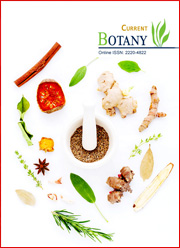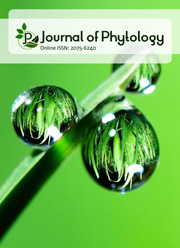Quantification of camptothecin and some flavonoids from Ixora javanica (Blume) DC by HPLC
DOI:
https://doi.org/10.25081/cb.2025.v16.8819Keywords:
Ixora javanica, Flavonoids, Alkaloids, Camptothecin, HPLCAbstract
Ixora javanica is a medicinally important plant reported to show anticancer, anti-inflammatory, antioxidant and hepatoprotective activities. The present study investigates four medicinally important phytoconstituents present in various parts of I. javanica. HPLC technique is used to detect the presence and quantities of three flavonoids rutin, kaempferol and quercetin in the leaves and flowers and alkaloid camptothecin in the bark and roots of I. javanica. Rutin was best extracted (43.92%) using 90% ethanol whereas quercetin (0.27%) was best extracted using 85% methanol both from the flowers of the plant. Kaempferol was best extracted from leaves (1.15%) using petroleum ether as a solvent. Alkaloid camptothecin was found to be present in bark (7.34%) as well as root extracts (3.52%) of I. javanica. However, higher camptothecin content was present in the bark as compared to the roots of the same plant. Both 60% methanol or 60% ethanol were found to be equally good solvents for camptothecin extraction from bark and root samples. This is the first report of HPLC quantification of alkaloid camptothecin from the bark and roots of I. javanica.
Downloads
References
Aguirre, L., Arias, N., Macarulla, M. T., Gracia, A., & Portillo, M. P. (2011). Beneficial Effects of Quercetin on Obesity and Diabetes. The Open Nutraceuticals Journal, 4, 189-198. https://doi.org/10.2174/1876396001104010189
Baliga, M. S., & Kurian, P. J. (2012). Ixora coccinea Linn.: traditional uses, phytochemistry and pharmacology. Chinese Journal of Integrative Medicine, 18, 72-79. https://doi.org/10.1007/s11655-011-0881-3
Bressolle, F., Bromet-Petit, M., & Audran, M. (1996). Validation of liquid chromatographic and gas chromatographic methods. Applications to pharmacokinetics. Journal of Chromatography B: Biomedical Sciences and Applications, 686(1), 3-10. https://doi.org/10.1016/S0378-4347(96)00088-6
Chen, L.-J., Zhang, Y., & Chen, Y.-G. (2016). Chemical Constituents of Plants from the Genus Ixora. Chemistry & Biodiversity, 13(3), 275-283. https://doi.org/10.1002/cbdv.201500065
Davis, J. M., Murphy, E. A., & Carmichael, M. D. (2009). Effects of the dietary flavonoid quercetin upon performance and health. Current Sports Medicine Reports, 8(4), 206-13. https://doi.org/10.1249/JSR.0b013e3181ae8959
Dontha, S., Kamurthy, H., & Manthripragada, B. (2015). Phytochemical and Pharmacological Profile of Ixora: A Review. International Journal of Pharmaceutical Sciences and Research, 6(2), 567-584. https://doi.org/10.13040/IJPSR.0975-8232.6(2).567-84
Efferth, T., Fu, Y.-J., Zu, Y.-G., Schwarz, G., Konkimalla, V. S., & Wink, M. (2007). Molecular target-guided tumor therapy with natural products derived from traditional Chinese medicine. Current Medicinal Chemistry, 14(19), 2024-2032. https://doi.org/10.2174/092986707781368441
Fischer, C., Speth, V., Fleig-Eberenz, S., & Neuhaus, G. (1997). Induction of Zygotic Polyembryos in Wheat: Influence of Auxin Polar Transport. The Plant Cell, 9(10), 1767-1780. https://doi.org/10.1105/tpc.9.10.1767
Ghoshal, D. S., Kharat, S. N., & Godbole, S. A. (2022a). Phytochemical and Comparative Assessment of Bark and Root Extracts of Ixora barbata Roxb. ex. Sm. and Ixora coccinea L. Using High-Performance Thin Layer Chromatography Assay. Indian Journal of Pharmaceutical Sciences, 84(3), 604-616. https://doi.org/10.36468/pharmaceutical-sciences.956
Ghoshal, D. S., Kharat, S. N., & Godbole, S. A. (2022b). HPTLC Quantification and Estimation of Rutin and Kaempferol using aerial parts of Ixora javanica (blume) dc. and Ixora barbata roxb. ex. sm. Research Journal of Pharmacy and Technology, 15(10), 4533-1. https://doi.org/10.52711/0974-360X.2022.00761
Govindachari, T. R., & Viswanathan, N. (1972). Alkaloids of Mappia foetida. Phytochemistry, 11(12), 3529-3531. https://doi.org/10.1016/S0031-9422(00)89852-0
He, X.-Z., Li, W.-S., Blount, J. W., & Dixon, R. A. (2008). Regioselective synthesis of plant (iso) flavone glycosides in Escherichia coli. Applied Microbiology and Biotechnology, 80, 253-260. https://doi.org/10.1007/s00253-008-1554-7
Hollman, P. C. H., Bijsman, M. N. C. P., van Gameren, Y., Cnossen, E. P. J., de Vries, J. H. M., & Katan, M. B. (1999). The sugar moiety is a major determinant of the absorption of dietary flavonoid glycosides in man. Free Radical Research, 31(6), 569-573. https://doi.org/10.1080/10715769900301141
Hooker, J. D. (1882). The Flora of British India. (Vol. III). Londan, UK: Spottiswoode.
Hussein, A. R., & El-Anssary, A. A. (2019). Plants Secondary Metabolites: The Key Drivers of the Pharmacological Actions of Medicinal Plants. In P. F. Builders (Eds.), Herbal Medicine London, UK: IntechOpen. https://doi.org/10.5772/intechopen.76139
Isah, T., & Umar, S. (2018). Influencing in vitro clonal propagation of Chonemorpha fragrans (moon) Alston by culture media strength, plant growth regulators, carbon source and photo periodic incubation. Journal of Forestry Research, 31, 27-43. https://doi.org/10.1007/s11676-018-0794-3
Janbaz, K. H., Saeed, S. A., & Gilani, A. H. (2002). Protective effect of rutin on paracetamol- and CCl4-induced hepatotoxicity in rodents. Fitoterapia, 73(7-8), 557-563. https://doi.org/10.1016/s0367-326x(02)00217-4
Javed, H., Khan, M. M., Ahmad, A., Vaibhav, K., Ahmad, M. E., Khan, A., Ashafaq, M., Islam, F., Siddiqui, M. S., & Safhi, M. M. (2012). Rutin prevents cognitive impairments by ameliorating oxidative stress and neuroinflammation in rat model of sporadic dementia of Alzheimer type. Neuroscience, 210, 340-352. https://doi.org/10.1016/j.neuroscience.2012.02.046
Kacprzak, K. M. (2013). Chemistry and Biology of Camptothecin and its Derivatives. In K. G. Ramawat & J. M. Mérillon (Eds.), Natural Products (pp. 643-682) Berlin, Heidelberg: Springer. https://doi.org/10.1007/978-3-642-22144-6_26
La Casa, C., Villegas, I., de la Lastra C. A., Motilva, V., & Calero, M. J. M. (2000). Evidence for protective and antioxidant properties of Rutin, a natural flavone, against ethanol induced gastric lesions. Journal of Ethnopharmacology, 71(1-2), 45-53. https://doi.org/10.1016/s0378-8741(99)00174-9
Li, Y., Yao, J., Han, C., Yang, J., Chaudhary, M. T., Wang, S., Liu, H., & Yin, Y. (2016). Quercetin, Inflammation and Immunity. Nutrients, 8(3), 167. https://doi.org/10.3390/nu8030167
Lin, J.-P., Yang, J.-S., Lin, J.-J., Lai, K.-C., Lu, H.-F., Ma, C.-Y., Wu, S.-C., Wu, K.-C., Chueh, F.-S., Wood, W. G., & Chung, J.-G. (2012). Rutin inhibits human leukemia tumor growth in a murine xenograft model in vivo. Environmental Toxicology, 27(8), 480-484. https://doi.org/10.1002/tox.20662
Mellou, F., Loutrari, H., Stamatis, H., Roussos, C., & Kolisis, F. N. (2006). Enzymatic esterification of flavonoids with unsaturated fatty acids: Effect of the novel esters on vascular endothelial growth factor release from K562 cells. Process Biochemistry, 41(9), 2029-2034. https://doi.org/10.1016/j.procbio.2006.05.002
Nassiri-Asl, M., Mortazavi, S.-R., Samiee-Rad, F., Zangivand, A.-A., Safdari, F., Saroukhani, S., & Abbasi, E. (2010). The effects of rutin on the development of pentylenetetrazole kindling and memory retrieval in rats. Epilepsy & Behavior, 18(1), 50-53. https://doi.org/10.1016/j.yebeh.2010.03.005
Oktaviyanti, N. D., Kartini, K., Hadiyat, M. A., Rachmawati, E., Wijaya, A. C., Hayun, H., & Munim, A. (2020). A green extraction design for enhancing flavonoid compounds from Ixora javanica flowers using a deep eutectic solvent. Royal Society Open Science, 7(10), 201116. https://doi.org/10.1098/rsos.201116
Park, J. S., Rho, H. S., Kim, D. H., & Chang, I. S. (2006). Enzymatic preparation of kaempferol from green tea seed and its antioxidant activity. Journal of Agriculture and Food Chemistry, 54(8), 2951-2956. https://doi.org/10.1021/jf052900a
PayÁ, M., Ferrandiz, M. L., Sanz, M. J., & Alcaraz, M. J. (1993). Effects of phenolic compounds on bromobenzene-mediated hepatotoxicity in mice. Xenobiotica, 23(3), 327-233. https://doi.org/10.3109/00498259309059386
Raju, M. G., Anusha, K., Suvarchala Reddy N. V. L., Gayathri, S., & Nikitha, K. (2021). GC-MS Analysis, Gastroprotective and In Silico Docking Studies of Phytoconstituents from Ixora javanica Flowers. International Journal of Life Science and Pharma Research, 11(2), 98-106 https://doi.org/10.22376/ijpbs/lpr.2021.11.2.P98-106
Richetti, S. K., Blank, M., Capiotti, K. M., Piato, A. L., Bogo, M. R., Vianna, M. R., & Bonan, C. D. (2011). Quercetin and rutin prevent scopolamine-induced memory impairment in zebrafish. Behavioural Brain Research, 217(1), 10-15. https://doi.org/10.1016/j.bbr.2010.09.027
Ross, J. A., & Kasum, C. M. (2002). Dietary flavonoids: bioavailability, metabolic effects, and safety. Annual Review of Nutrition, 22, 19-34. https://doi.org/10.1146/annurev.nutr.22.111401.144957
Saeed, M. A., Ansari, M. T., Ch, B. A., & Zaman, M. (2020). RP-HPLC Method for the Determination and Quantification of Artesunate. Journal of Chromatographic Science, 58(8), 695-699. https://doi.org/10.1093/chromsci/bmaa037
Satari, A., Ghasemi, S., Habtemariam, S., Asgharian, S., & Lorigooini, Z. (2021). Rutin: A Flavonoid as an Effective Sensitizer for Anticancer Therapy; Insights into Multifaceted Mechanisms and Applicability for Combination Therapy. Evidence-Based Complementary and Alternative Medicine, 2021, 913179. https://doi.org/10.1155/2021/9913179
Schwedhelm, E., Maas, R., Troost, R., & Boger, R. H. (2003). Clinical pharmacokinetics of antioxidants and their impact on systemic oxidative stress. Clinical Pharmacokinetics, 42(5), 437-459. https://doi.org/10.2165/00003088-200342050-00003
Tadeusz, A. (2015). Alkaloids: Chemistry, Biology, Ecology, and Applications. (2nd ed.). Amsterdam, Netherlands: Elsevier.
Trumbeckaite, S., Bernatoniene, J., Majiene, D., Jakstas, V., Savickas, A., & Toleikis, A. (2006). The effect of flavonoids on rat heart mitochondrial function. Biomedicine & Pharmacotherapy, 60(5), 245-248. https://doi.org/10.1016/j.biopha.2006.04.003
Yerragunta, V., Sunitha, D., & Ramesh, A. (2016). Phytochemical Evaluation of Anti-Inflammatory Activity of Different Solvents Extracts of Ixora javanica Flowers. Natural Products Chemistry & Research, 4(3), 1-3. https://doi.org/10.4172/2329-6836.1000219
Yoshida, T., Konishi, M., Horinaka, M., Yasuda, T., Goda, A. E., Taniguchi, H., Yano, K., Wakada, M., & Sakai, T. (2008). Kaempferol sensitizes colon cancer cells to TRAIL-induced apoptosis. Biochemical and Biophysical Research Communications, 375(1), 129-133. https://doi.org/10.1016/j.bbrc.2008.07.131
Zu, Y., Li, C., Fu, Y., & Zhao, C. (2006). Simultaneous determination of Catechin, Rutin, Quercetin Kaempferol and isorhamnetin in the extract of sea buckthorn (Hippophae rhamnoides L.) leaves by RP-HPLC with DAD. Journal of Pharmaceutical and Biomedical Analysis, 41(3), 714-719. https://doi.org/10.1016/j.jpba.2005.04.052
Published
How to Cite
Issue
Section
Copyright (c) 2025 Dipanwita S. Ghoshal, Gokul Ganesan, Sopan N. Kharat, Sangeeta A. Godbole

This work is licensed under a Creative Commons Attribution-NonCommercial 3.0 Unported License.



 .
.